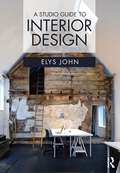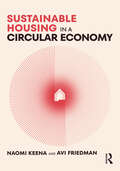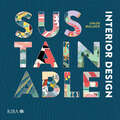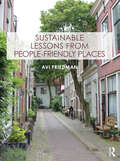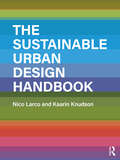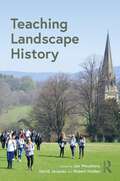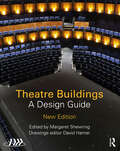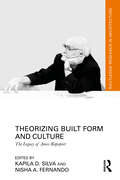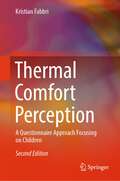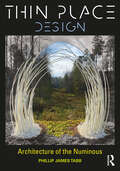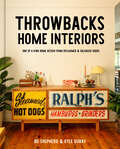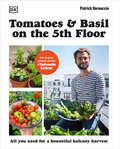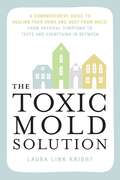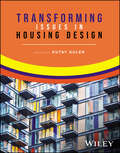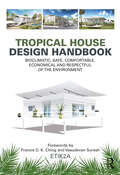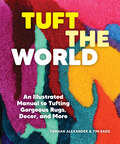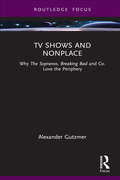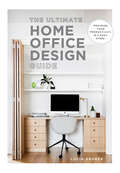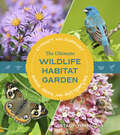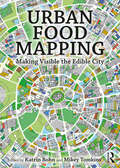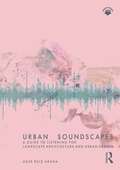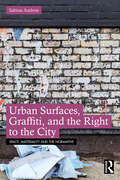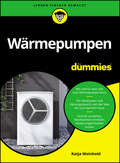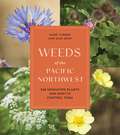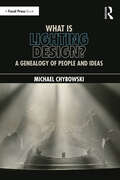- Table View
- List View
A Studio Guide to Interior Design
by Elys JohnA Studio Guide to Interior Design leads you through the creative process of developing an interior design proposal. From reading existing buildings, to presenting the final design, each stage is illustrated with analytical diagrams demonstrating clearly the workflow, processes and skills needed at each stage of the design process. Throughout the book there are key references to drawing, digital practice, author illustrated diagrams and design precedents. The book shows how to effectively read existing architecture and interiors and sets out orthographic drawing principles, to be used as an integral part of conceptual design development. It also looks at the integration of technology within the design process. The book has a complementary focus towards hand drawing and digital practice and uses a case study driven, diagrammatic approach so students can readily apply programmatic concepts to their own project context. Ideally suited to students at the beginning of their course, the book covers everything students need to get to grips with early on in their studies and features a wealth of pedagogical features.
Sustainable Housing in a Circular Economy
by Naomi Keena Avi FriedmanThis book relates circular economy principles to housing design and construction and highlights how those principles can result in both monetary savings, positive environmental impact, and socio-ecological change.Chapters focus on three key circular economy principles and apply them to architectural construction and design, namely rethinking of the end-of-use phase of a building and the potential of design-for-disassembly; the role of digitization and data standardization in fostering evidence-based circular economy design decision-making; and presenting space as a resource to conserve, via exploration of the sharing economy and flexibility principles. Beyond waste management and material cycles, this book provides a holistic understanding of the opportunities across the building life cycle that can allow for sustainable and affordable circular housing. With case studies from 13 different countries, including but not limited to the Hammarby Sjöstad district in Sweden, the Circle House in Denmark, Benny Farm in Canada, VMD Prefabricated House in Mexico, and the Deep Performance Dwelling in China, authors pair theoretical frameworks with real-world examples.This will be a useful resource for upper-level students and academics of architecture, construction, and planning, especially those studying and researching housing design, building technology, green project management, and environmental design.
Sustainable Interior Design
by Chloe BullockWhat does it mean to be a sustainable interior designer? Where do you start? This book demystifies how to be a sustainable interior designer, both within practice and on design projects. It gives you the tools to educate clients that sustainable practice isn’t necessarily more expensive, and what the options available to them are in terms of design concept, materials and finishes. Importantly, the book also looks at sustainable supply chains, particularly important when specifying FF+E. Where to start being sustainable can be a difficult decision. Acting as a primer for interior designers at any stage of their career, it outlines what you really need – and don’t need – to know. Inspirational case studies from around the world sit alongside crucial guidance on the benefits of being sustainable and how to work with enlightened clients. There is information on how sustainable design contributes to health and wellbeing, all backed up by authoritative best practice guidance.
Sustainable Lessons from People-Friendly Places
by Avi FriedmanCurrent planning and design modes of cities are facing challenges of philosophy and form. Past approaches no longer sustain new demands and call for innovative thinking. In a world that is becoming highly urbanized, the need for a new outlook is propelled by fundamental global changes that touch upon environmental, economic and social aspects.The book introduces fundamental principles of timely sustainable urban design, paying attention to architecture, integration of natural features, public urban spaces and their successful use. Readers will learn how cities are transitioning to active mobility by placing the wellbeing of citizens at the heart of planning; making buildings fit nature; supporting local culture through preservation; and including community gardens in neighborhoods, among others. Written by a practicing architect, professor and author, the book is richly illustrated and features meticulously selected international case studies.
The Sustainable Urban Design Handbook
by Nico Larco Kaarin KnudsonThe Sustainable Urban Design Handbook gathers the best sustainability practices and latest research from the fields of architecture, landscape architecture, planning, development, ecology, and environmental engineering and presents them in a graphically rich and accessible format that can help guide urban design decisions in cities of all sizes.The book presents a comprehensive framework that organizes more than 50 elements of sustainable urban design under five main topics–Energy Use & Greenhouse Gas, Water, Ecology & Habitat, Energy Use & Production, and Equity & Health–and relative to four project scales: Region & City, District & Neighborhood, Block & Street, and Project & Parcel. Each element chapter includes a summary of importance and background, compares typical practices and recommended approaches, explains connections to other elements, and concludes with urban design guidelines that can be used to directly inform projects and decisions.Easy to use and reference, The Sustainable Urban Design Handbook provides both an in-depth introduction to topics across sustainable urban design and serves as an on-going reference for anyone involved in the creation of sustainable urban environments. This resource will be useful to design and planning professionals, community members, students, and elected officials in guiding decisions about our sustainable future.
Teaching Landscape History
by Jan Woudstra David JacquesLandscape history is changing in content and style to address the issues of today. Experienced teachers and authors on the history of gardens and landscapes come together in this new volume to share ideas on the future of teaching history in departments of landscape architecture, archaeology, geography and allied subjects. Design history remains important, but this volume brings to the fore the increasing importance of environmental history, economic history, landscape history, cultural landscapes, environmental justice and decolonisation, ideas of sustainability and climate change amelioration, which may all be useful in serving the needs of a widening range of students in an increasingly complex world. The main themes include: what history should we narrate in the education of landscape architects? how can we recognise counter-narratives and our own bias? how should we engage the students in the history of their chosen profession? how can designers and researchers be persuaded of the relevance of history teaching to theory and practice? and what resources do we need to develop teaching of landscape histories? This book will be of interest to anyone teaching courses on landscape architecture, urban design, horticulture, garden design, architectural history, cultural geography and more.
Theatre Buildings: A Design Guide
by Margaret Shewring David HamerIn 2021, its Diamond Jubilee year, the Association of British Theatre Technicians (ABTT) undertook to revise Theatre Buildings: A Design Guide (Routledge, 2010). This new edition (Routledge, 2023) has substantially re-written text with fresh images and entirely new reference projects, providing essential guidance for all those engaged in the design of theatre buildings. Edited by Margaret Shewring (Emeritus Reader, University of Warwick, former Director of the Postgraduate Diploma and MA in Theatre Consultancy), this new publication is written by a team of international experts, architects, theatre consultants, acousticians, engineers and industry professionals led by Tim Foster (Foster Wilson Size) and Robin Townley (CEO of the ABTT). It provides an invaluable resource for those looking to build, remodel or conserve theatre buildings, taking into account the significant changes which have taken place in the last twelve years in all aspects of theatre design and technical practice. It locates those changes in the wider context of the need for sustainability in the theatre industry in response to the climate emergency, inclusivity, diversity of access, placemaking and concerns for health and wellbeing. This new edition provides guidance for anyone who seeks inspiration and encouragement to create or improve a place of entertainment or who seeks to understand what might be required to accommodate an audience for the presentation of live performance and the successful use, operation and organisation of such a venue. Its generous format and the thirty-two new reference projects, more than 260 high-resolution colour images and 175 diagrams and specially commissioned plans make it accessible and informative both to the general reader and the professional specialist.
Theorizing Built Form and Culture: The Legacy of Amos Rapoport (Routledge Research in Architecture)
by Kapila D. Silva Nisha A. FernandoIn this collection of essays, Theorizing Built Form and Culture: The Legacy of Amos Rapoport – a felicitation volume to celebrate the significance of Professor Amos Rapoport's lifelong scholarship – scholars from around the world discuss the analytical relevance, expansion, and continuing application of these contributions in developing an advanced understanding of mutual relationships between people and built environments across cultures.Professor Amos Rapoport has espoused an intellectual and theoretical legacy on environmental design scholarship that explains how cultural factors play a significant role in the ways people create and use environments as well as the way environments, in turn, influence people’s behavior. This volume presents a hitherto-not-seen, unique, and singular work that simultaneously articulates a cohesive framework of Rapoport’s architectural theories and demonstrates how that theoretical approach be used in architectural inquiry, education, and practice across environmental scales, types, and cultural contexts. It also acknowledges, for the very first time, how this theoretical legacy has pioneered the decolonizing of the Eurocentric approaches to architectural inquiry and has thus privileged an inclusive, cross-cultural perspective that laid the groundwork to understand and analyze non-Western design traditions. The book thus reflects a wide range of cross-cultural and cross-contextual range to which Professor Rapoport’s theories apply, a general notion of theoretical validity he always advocated for in his own writings.The volume is a paramount source for scholars and students of architecture who are interested in understanding how culture mediates the creation, use, and preservation of the built environment.
Thermal Comfort Perception: A Questionnaire Approach Focusing on Children (Springerbriefs In Applied Sciences And Technology Ser.)
by Kristian FabbriThis book offers a comprehensive exploration of children's understanding and experiences of thermal comfort. The book provides a methodology for evaluating comfort that takes into account the unique perspectives of children. The first part of the book provides an overview of the history of thermal comfort, the human body and environmental parameters, and common thermal comfort indexes. It also offers guidelines for creating questionnaires that accurately assess children's perceptions of indoor thermal comfort. The book then delves into children's understanding of the concepts of comfort and energy, as well as the factors that influence their perception of these concepts. It addresses the psychological and pedagogical aspects of thermal comfort judgment, as well as the architectural and environmental characteristics that contribute to children's perceptions of comfort. First published as Indoor Thermal Comfort Perception, this updated edition also includes new sections on architecture and sensitivity, exploring the impact of classroom spaces on learning, and outdoor education and thermal comfort outdoors, based on qualitative research. These additions provide valuable insights for future studies on these topics. While physical parameter measurements and comfort indexes are useful in thermal comfort, the book emphasizes the importance of ergonomic assessments in the form of questionnaires, which offer unique insights into children's experiences. The book fills a critical gap in understanding children's perceptions of thermal comfort and is essential reading for HVAC engineers, architects, environmental psychologists, and researchers in the medical and cognitive fields.
Thin Place Design: Architecture of the Numinous
by Phillip James TabbWhat makes the places we inhabit extraordinary? Why are some urban spaces more vital and restorative? Wonderful landscapes, inspiring works of architecture and urban design, and the numinous experiences that accompany them have been an integral dimension of our culture. Up-lifting spaces, dramatic use of natural light, harmonic proportional geometry, magical landscapes, historic sites and vital city centers create special, even sacred moments in architecture and planning. This quality of experience is often seen as an aesthetic purpose intended to inspire, ennoble, ensoul and spiritually renew. Architecture and urban spaces, functioning in this way, are considered to be thin places.
Throwbacks Home Interiors: One of a Kind Home Design from Reclaimed and Salvaged Goods
by Bo Shepherd Kyle DubayA stunningly photographed collection of homes featuring sustainable designs that celebrate the ingenuity of reclaimed materials and unexpected antiques, from the founders of Detroit-based furniture design brand Woodward Throwbacks.In an effort to celebrate the unique and beautiful material that is often scrapped in renovations Bo Shepherd and Kyle Dubay founded Woodward Throwbacks, which creates original furniture and home goods using reclaimed materials salvaged in Detroit. In Throwbacks Home Interiors, they dive into the creativity of home salvage, showing readers how to incorporate found and reclaimed materials into their home décor and furniture. Each chapter showcases inspiration for incorporating salvaged materials into your home in new ways, includingUpscale furnishings made from unexpected materials, like old signs turned into a credenzaWays to incorporate original hardware, flooring, or trim into any style, whether you prefer a more traditional look, a modern sleek design, or an eclectic mix.Spotlights on various materials and how to include them in your home, whether that's using a marble remnant to make a brand new countertop, turning broken tiles into a bespoke backsplash, or using offcuts of wood to create a one of a kind gorgeous side table.Tips for finding salvaged and reclaimed material as well as insights into thrifting furniture and finding old things to love in your new home.Along the way, authors Bo Shepherd and Kyle Dubay give readers the tools to bring that unique style home. For fans of historic details and homes with a story, Throwbacks Home Interiors offers plenty of inspiration for reusing, restyling, and elevating items that you find or love, matching modern with antique for a home that is stylish and personal.
Tomatoes and Basil on the 5th Floor (The Frenchie Gardener)
by Patrick VernuccioGet the most out of every bit of balcony space to easily grow your own sustainable, organic, and tasty food.Do you love having a balcony but aren't sure how you can use it as a space to grow? Do you feel that being a few stories up in a building stops you from growing delicious crops? If the answer is "yes," then it's time you read this book.Patrick Vernuccio is a small-space grower with a big message-and even bigger Instagram following. Building on Patrick's popular 60-second reels, Tomatoes and Basil on the 5th Floor will showcase easy and informative ways to grow fresh produce in containers and on a balcony.From dividing store-bought basil plants, to harvesting vegetables at the best time of year, to letting plants set seed for the benefit of wildlife, Patrick takes his readers through myriad ways to get crops and produce out of very limited space. Working with the seasons and with good-quality seed and compost, he explains all you need to know to ensure every inch of your balcony can give you tasty and beautiful crops to harvest.
The Toxic Mold Solution: A Comprehensive Guide to Healing Your Home and Body from Mold: From Physical Symptoms to Tests and Everything in Between
by Laura Linn KnightA Simon & Schuster eBook. Simon & Schuster has a great book for every reader.
Transforming Issues in Housing Design
by Kutay GulerTRANSFORMING ISSUES IN HOUSING DESIGN A practical and complete resource for students, researchers, and practitioners of housing design Transforming Issues in Housing Design delivers a comprehensive vision for the design, philosophy, psychology, efficiency, and constitution of housing. This collection of articles explores many of the most pressing and relevant issues related to the ongoing transformation of housing design. Twenty-two contributed chapters discuss the past and current state of housing design, how it evolved to become what it is today, and, finally, how it may unfold in the future. A team of global experts presents the most up-to-date research and a diverse and illuminating collection of examples to highlight housing design around the world. Readers will also find: A thorough introduction to modern housing design and how it relieves and contributes to various social and economic problems Insightful explorations of the built environment, interior architecture, urban design, sustainable living, space planning, and more Practical discussions of a theoretical framework to make sense of housing design concepts Complete treatments of concepts, research, and built projects from a diverse range of communities and cultures Perfect for architects and students of urban studies, interior design, and architecture, Transforming Issues in Housing Design will also benefit those who design, research, and teach housing.
Tropical House Design Handbook: Bioclimatic, Safe, Comfortable, Economical and Respectful of the Environment
by Etik2aPacked with accessible information, this book covers all the technical and practical aspects of home design in tropical environments. . It begins by outlining the prerequisites needed to understand the issues involved (climate, heat, thermal comfort, etc.) and discusses the solutions offered by traditional housing. It then identifies current solutions for protecting buildings and their occupants from solar radiation and external heat, while promoting bioclimatic and environmentally friendly approaches. . The economic viability of the solutions identified is discussed, as are the advantages and disadvantages of the materials, depending on the context and standards in force. . Numerous examples illustrate how buildings can be adapted to local realities, from the avant-garde creations of Jean Prouvé to those of today’s architects who are committed to sustainable development, as well as specific projects incorporating the recommendations made in this book. More than 460 photos, drawings, diagrams, tables, maps, house plans, logos and pictograms illustrate this reference work for all those involved in construction in tropical regions, particularly students in the field and, more generally, anyone – from professionals to private individuals – looking for useful information on this subject.
Tuft the World: An Illustrated Manual to Tufting Gorgeous Rugs, Decor, and More
by Tiernan Alexander Tim EadsA visual how-to guide on the craft of tufting rugs, home decor, and more from the duo behind Tuft the World, the tufting company that has helped launch and educate a new generation of tufters.Tuft the World is an easy-to-follow and beautifully illustrated guide to tufting, whether you’re creating your first project or are a seasoned tufter. Brought to you by the preeminent experts in the machine-tufting field, this detailed crafting guide shows you, through step-by-step instructions and 175 full-color photographs, how to create contemporary, stylish, and enjoyable machine-tufted rugs, clothes, and objects. Within these pages, you'll learn about:Tufting machines, materials, and techniquesWorkspace setupHow to create projects from start to finish, including everything from a bathmat, bedside rug, shawl collar, or chair slipcover to a picture frame, sculptural work of art, or stunning tufted cat tree!Contemporary rug artists and their designsThe history of tufting and some of the women and men whose inventions brought the craft to lifeAnd moreUnlike online videos about tufting, this book is a long-lasting reference showcasing the versatility and creativity of the craft by the experts—a highly accessible, thorough, and enriching guide. Included throughout are sidebars on the historical context for amateur and professional rug-making in America and spotlights on current tufting makers.This much-needed companion introduces and expands knowledge for the many new and experienced tufters interested in the booming craft of machine-tufted rugs and decor. Inspiring and simple to follow, this book is sure to make a tufter out of anyone.
TV Shows and Nonplace: Why The Sopranos, Breaking Bad and Co. Love the Periphery (Routledge Focus on Television Studies)
by Alexander GutzmerThis book scrutinizes the relationship between contemporary TV shows and space, focusing on the ways in which these shows use and narrate specific spatial structures, namely, spaces far away from traditional metropolises. Beginning with the observation that many shows are set in specific spatial settings, referred to in the book as “nonplace territories” – e.g., North Jersey, New Mexico, or rural and suburban Western Germany – the author argues that the link between such nonplace territories and shows such as The Sopranos, Breaking Bad, or Dark is so intense because the narrative structure functions similarly to these territories: flat, decentralized, without any sense of structure or stable hierarchy. The book takes three different perspectives: first, it looks at the rationale for combining TV shows and nonplace territories from the viewpoint of narrative strategy. It then thinks through what these strategies mean for practicing architects. Finally, it approaches the arguments made before from a “user” perspective: what does this narrative mirroring of social-spatial reality in places such as Albuquerque or Jersey City mean for people living in these places? This new approach to architecture and space on screen will interest scholars and students of television studies, screen architecture, media and architectural theory, and popular culture.
The Ultimate Home Office Design Guide: Maximize your productivity in 5 easy steps
by Lucia GruberIn The Ultimate Home Office Design Guide, discover the secrets to transforming your home office into a dynamic and efficient workspace that unleashes your full potential.With the unprecedented rise of remote work, the home office has become more than just a luxury—it&’s a necessity, even considered a new lifestyle. However, without the right environment, distractions and inefficiencies can hinder your productivity and creativity. That&’s where this indispensable guide comes in. Whether you&’re new to working from home or seeking to revamp your existing setup, The Ultimate Home Office Design Guide is tailored to address the unique challenges and opportunities presented by this evolving work landscape.Drawing upon years of research and experience, renowned designer Lucia Gruber takes you on a transformative journey through five simple steps to create the ultimate home office. From optimizing your physical space to enhancing your psychological well-being, each step is carefully crafted to maximize your productivity and ensure peak performance.Learn how to choose the ideal location within your home, harness natural light, and utilize ergonomic furniture to create a comfortable and inspiring workspace. Discover the secrets of effective storage solutions, organizing techniques, and how to minimize distractions to maintain focus and flow.
The Ultimate Wildlife Habitat Garden: Attract and Support Birds, Bees, and Butterflies
by Stacy TornioThis beginner-friendly handbook helps homeowners create a beautiful garden that attracts birds, bees, butterflies, and more. In The Ultimate Wildlife Habitat Garden, Stacy Tornio makes it easy to attract birds, bees, and butterflies to your home garden by sharing details about which plants attract specific creatures. Entice birds with black-eyed susans, attract bumblebees by planting bee balm, and more. Choose from ten garden plans, including a hummingbird garden, a birdseed garden, and options that are low-maintenance and drought-resistant. You&’ll also get advice on finding the right feeder, avoiding pesticides, and choosing native plants. This beautiful, photo-filled guide will enable you to create the earth-friendly garden of your dreams.
Urban Food Mapping: Making Visible the Edible City
by Katrin Bohn Mikey TomkinsWith cities becoming so vast, so entangled and perhaps so critically unsustainable, there is an urgent need for clarity around the subject of how we feed ourselves as an urban species. Urban food mapping becomes the tool to investigate the spatial relationships, gaps, scales and systems that underlie and generate what, where and how we eat, highlighting current and potential ways to (re)connect with our diet, ourselves and our environments.Richly explored, using over 200 mapping images in 25 selected chapters, this book identifies urban food mapping as a distinct activity and area of research that enables a more nuanced way of understanding the multiple issues facing contemporary urbanism and the manyfold roles food spaces play within it. The authors of this multidisciplinary volume extend their approaches to place making, storytelling, in-depth observation and imagining liveable futures and engagement around food systems, thereby providing a comprehensive picture of our daily food flows and intrastructures. Their images and essays combine theoretical, methodological and practical analysis and applications to examine food through innovative map-making that empowers communities and inspires food planning authorities. This first book to systematise urban food mapping showcases and bridges disciplinary boundaries to make theoretical concepts as well as practical experiences and issues accessible and attractive to a wide audience, from the activist to the academic, the professional and the amateur. It will be of interest to those involved in the all-important work around food cultures, food security, urban agriculture, land rights, environmental planning and design who wish to create a more beautiful, equitable and sustainable urban environment.
Urban Soundscapes: A Guide to Listening for Landscape Architecture and Urban Design
by Usue Ruiz AranaSound and listening are intrinsically linked to how we experience and engage with places and communities. This guide puts forward a new conceptual framework of embodied affectivity that emphasises listening in urban research and design and advances new ways of knowing and making. The guide invites landscape architects and urban designers to become soundscape architects and offers practical advice on sound and listening applicable to each stage of a design project: from reading the environment to intervening on it.Urban Soundscapes foregrounds listening as an affective mediator between subjects and multispecies environments, and a vehicle to think and conceptualise environmental research and design beyond prevailing visual and human-centred modes. The guide expands landscape architects’ and urban designers’ tools and skills to assess existing soundscapes, predict how those soundscapes will be altered through their designs, consider sound as a creative and active part of the design process and envisage how users might perceive and be affected by those soundscapes as they evolve in time. The volume sits in the interface of research and practice and interweaves theoretical, methodological and creative contributions from acoustic ecology, ecoacoustics, bioacoustics and sound art. Each of the design stages is illustrated through project examples that demonstrate the many advantages of incorporating attentive listening and sound into Landscape Architecture and Urban Design Practice. This book shows how incorporating listening and sounding as part of the design process promotes slow and subtle ways of practice, adds social and ecological value through the reduction of noise pollution and by monitoring the health of habitats, and enables the design of soundscapes that complement the character and design intent of a scheme and elicit joy and wonder.The book will be of interest to practitioners and academics in landscape architecture, and other design and spatial fields such as urban design, architecture, geography and engineering, who play a primary role in the composition of the soundscape.
Urban Surfaces, Graffiti, and the Right to the City (ISSN)
by Sabina AndronThis book explores the ownersheir authorship and management, and their role in struggles for the right to the city. Includes a critical history of graffiti and street art as contested surface discourses. Interdisciplinary appeal.
Wärmepumpen für Dummies (Für Dummies)
by Katja WeinholdSie möchten verstehen, wie Wärmepumpen funktionieren, wie Sie sie in Ihr (bestehendes) Heiz- und Kühlsystem optimal integrieren, welche Förderung Sie erhalten und welche Kosten im Falle eines Einbaus auf Sie zukämen? Dann ist dieses Buch wie für Sie gemacht. Es erklärt die Technik leicht verständlich, macht mögliche Kosten transparent und unterstützt Sie so bei der Entscheidungsfindung. Darüber hinaus zeigt es Ihnen ganz konkret, welche Schritte Sie unternehmen müssen, wenn Sie sich für einen Einbau entscheiden.
Weeds of the Pacific Northwest: 368 Unwanted Plants and How to Control Them
by Sami Gray Mark TurnerA comprehensive guide to the most common weeds of the Pacific Northwest, with essential information on their management and eradication Weeds are everywhere. They crowd out valuable agricultural crops, compete with the tomatoes and beans in your vegetable garden, spread rampantly along roadsides, and pop up from the tiniest cracks in sidewalks. In order to manage them, we must first learn how to identify them. Weeds of the Pacific Northwest is a guide to identifying, controlling, and eradicating over 300 species of weeds that gardeners and homeowners are likely to encounter in Northern California, Oregon, Washington, and British Columbia. Though they can all cause trouble, each weed is different. The hundreds of user-friendly photographs and detailed descriptions of each species here ensure that you can spot and treat any weed in your path. As the experts behind this book demonstrate, some plants can be killed by eating them, some by digging, some by smothering, and some only by the judicious application of chemical herbicides—and it is very important for you and your neighbors to know and understand the differences.
What Is Lighting Design?: A Genealogy of People and Ideas
by Michael ChybowskiWhat Is Lighting Design?: A Genealogy of People and Ideas explains what lighting design is by looking at the history of ideas that are a part of this craft and how those ideas developed. Lighting design began in the West with the Renaissance, and each historical period since then has modified how and why light is used in performance, the methods for producing light, and the consensus around what its purpose is. Exploring each lighting design era and the basic components of lighting design, the book discusses how the central ideas of this craft developed over the past 500 years, what today’s lighting designers are concerned with, and how lighting design contributes to performances. This book is designed as a main course text for History of Lighting Design university courses and a supplementary text for and Introduction to Lighting Design, Stagecraft, and Scenography courses. It will also be of interest to directors, choreographers, and working lighting designers who wish to explore the history and meaning of their craft.
